The Northern Weekly Salvo
Incorporating Slaithwaite Review of Books, Weekly Notices, Sectional Appendices, Tunnel Gazers’ Gazette etc. Descendant of Teddy Ashton’s Northern Weekly and Th’Bowtun Loominary
Published at 109 Harpers Lane Bolton BL1 6HU email: paul.salveson@myphone.coop
Publications website: www.lancashireloominary.co.uk
No. 300 December 24th CHRISTMAS SPECIAL
Salveson’s half-nakedly political digest of railwayness, tripe and secessionist nonsense from Up North. Sometimes weekly, usually not; definitely Northern.

General gossips of a personal nature
Flippin’ ‘eck, the 300th Salvo! Not like me to be so consistent, though it’s a while since I was able to produce a weekly version. I’m glad it has kept going, mainly down to people telling me, usually in chance meetings, that they like getting it. So look out for Salvo 301 sometime in January. A very big thanks for the interest and support from everyone, including those who have dared to disagree with the infinite wisdom bestowed on you all, through The Salvo.
Christmas Eve has mixed memories for me. I used to love it as a boy, looking forward to the big day; I think the most memorable present was a Hornby Dublo model of ‘Duchess of Buccleuch’, 46232, when I was eight. I have less fond memories of Christmas Eve 2008 when Jo and myself were ushered into a hospital room to be given the news that Jo’s cancer had spread and really, that was it. And they had done their best. You’d think we would have had a truly dreadful Christmas, but not so. We walked up to West Nab on Christmas Day and did more local walks before New Year. January was dreadful and the end came on a snowy day early in February. But I can look back on over ten years’ of fun and enjoyment.
A lot more people have experienced death of loved ones in the last couple of years. I’ve been lucky not to have been affected too closely though the loss of Manu Mistry was a very sad blow. So too some good friends in the ‘railway family’ REPTA like Bryan and Ian who passed away this year. We must not forget them, and the thousands more who have gone before their time, as well as the amazing people in our NHS who have worked long and hard to help get us through this.
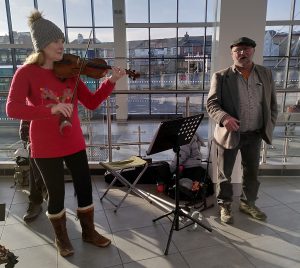
Let’s not get too miserable though – I’ve just watched the wonderful ‘Blackburn Sings Christmas’ organised by Gareth Malone, involving the people of Blackburn – especially its front-line NHS workers. The best show we’re likely to see over Christmas, even including ‘We Wish You a Mandy Christmas’ which came complete with John Cooper-Clarke.
A very happy Christmas and New Year to all my long-suffering readers.
General gossips of a political nature
Politics in 2021 has been pretty bleak, in many ways, at least until very recently. A welcome Christmas present was the Lib Dems’ win in North Shropshire – a clear pointer that people are well and truly fed up with the present administration. It’s also a signal that people have enough common sense to vote tactically. Could the same approach work in a general election, if there isn’t a formal deal between the opposition parties? I’m coming round to the view that if we are going to get a progressive government it’s very much down to what happens in England, with voters using their common sense to select the candidate with most chance of beating the Tory incumbent. I don’t think a formal ‘pact’ is the right thing to do, but welcome readers’ views on that.
In some places the ‘main opposition’ will be Labour, in others Lib Dem. That implies -and seems to have been the case in North Shropshire – that one of the main opposition parties gets an easy run, with minimal campaigning by the other opposition parties, without a formal arrangement.
The Lib Dems shouldn’t run away with the idea that they are now in second place against the Tories, in England; they aren’t. Labour still is, though the Lib Dems should be well placed to make gains in more rural seats and parts of the South where Labour doesn’t stand a chance. That’s difficult for the Greens where realistically the best they could
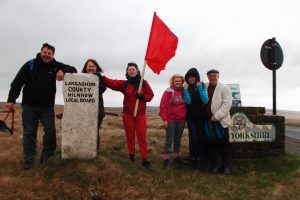
hope for is retaining the excellent Caroline Lucas. The better they do the more likely they are to split the progressive vote and let the Tory in. It’s an old dilemma, but they need to recognise that the only chance they have of getting seats is to have a Labour Government supported by the Lib Dems and SNP and Plaid Cymru, bringing in proportional representation. For now, the Greens’ best hope is to build up their support in local elections, where they can offer something distinctive and relevant. The same goes for the emerging regionalist parties in the North. A long haul.
The Integrated Rail Plan: A Considered View
The Rail Reform Group has published what it rightly terms ‘a considered view’ of the much-criticised Integrated Rail Plan. The full version of the paper has a link below – but to give you a taster, here is an excerpt….
The background to the Integrated Rail Plan (IRP) is that the country is still going through a pandemic that has ravaged its finances and changed the market for travel to the extent that rail has lost as much as 50% of its commuting business. Despite this, the Government is still prepared to invest £96bn in rail infrastructure for the North and Midlands. This is a massive vote of confidence in both rail and the economies of the North and Midlands. That should be a cause for celebration, not cries of betrayal, which for the most part seem to be politically motivated.
The IRP was intended to identify how HS2, Northern Powerhouse Rail and Midlands Rail Hub would dovetail together for a network of high speed routes, exploring the scope for shared use of new infrastructure and setting out an overarching delivery schedule in order to deliver maximum benefits quicker and to
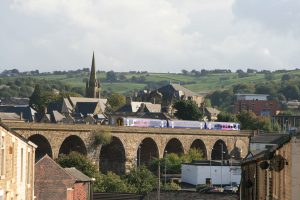
provide a realistic workbank for the supply industry. It was not meant to be a total blueprint for the Midlands and North. This means that proposals such as the Leamside Line are considered to be City Region schemes with alternative funding streams. This may be why no mention was made of Manchester’s Castlefield Corridor, for which there are ongoing workstreams. Incidentally, it does appear that IRP would take two paths off this corridor in each direction; a Liverpool-Manchester Airport semi-fast and a Redcar-Manchester Airport based on the current timetable.
A lot of the criticism is that ‘only’ upgraded lines and not new build is to be provided. Do passengers really care whether the line is new or upgraded if the trains are fast, frequent, comfortable and, of course, on time? An electrified, resignalled and improved Transpennine and Midland Main Lines (MML) is precisely the investment that has been called for over many years. Whilst ‘upgrading’ implies disruption to services on the existing lines, the industry has improved its management of the required blockades. New Build implies less disruption to existing services, but there will be wider community impacts. If one regards Ditton Junction to Marsden as a new railway, this would then be a similar mileage to the proposed Manchester – Leeds via Bradford route.
Until IRP there were two schemes; the Transpennine Rail Upgrade (TRU), which seemed something of a patchwork of smaller schemes, but are at least already in delivery or under development. This included Manchester-Victoria-Stalybridge electrification, Huddersfield-Ravensthorpe quadrupling and electrification and Colton Junction – Church Fenton electrification. Then there was the showcase new build NPR line linking Manchester to Leeds via Bradford. Both these projects seemed to involve a degree of duplication, that would inevitably push NPR into the distant future while short and medium terms investment focussed on a series of TRU schemes. What we get now is a combination of the two, with the intention of more benefits being delivered sooner.
Commentators refer to a Warrington to Marsden new high-speed line but have missed the point that what is being delivered is a new fast electrified main line between Liverpool and Manchester. The IRP should have majored on this. The Ditton Junction – Warrington Bank Quay Low Level line, now virtually disused since Fiddlers Ferry power station closed, will be rebuilt as a high-speed electrified line that reaches to within ten miles of Liverpool. That remaining ten miles is a four-track railway with spare capacity, except for a short section at Wavertree Junction, and all of this will doubtless be modernised to fulfil its new NPR role. This new main line from Liverpool and Warrington will be linked by new build to HS2 thus giving them direct HS2 services to Birmingham and London as well as NPR services to Manchester and Leeds. Provision for the new junction from HS2 to the Liverpool direction is already in development under HS2 phase 2b and the route into Manchester (mostly tunnel from the Airport) is already specified. This is precisely the synergy that IRP was intended to deliver.
https://railreformgroup.org.uk/the-integrated-rail-plan-a-considered-response
Building on Success: future directions for Community Rail
After many iterations and debate, I’ve produced a ‘final’ version of my paper Building on Success; Future directions for Community Rail. A link to the full version is below but the Preface gives a flavour and context:
This paper is aimed at a range of people active in the rail and transport industry as well as in the wider public sector – local government, combined authorities – and the ‘third sector’. I’m grateful to many friends and colleagues for their input to the paper, though I bear prime responsibility for what’s in it. The Rail Reform Group has kindly agreed to host the paper on its website and the same caveat applies.
I was involved in setting up the movement that became ‘Community Rail’ in the early 1990s, through a report called New Futures for Rural Rail. We launched it
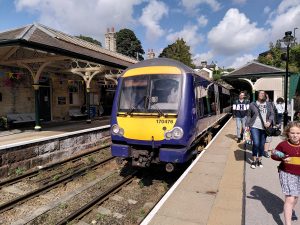
at the National Railway Museum in 1992. This paper is my own personal revision of ‘New Futures’, throwing up ideas and suggestions for Community Rail that can go forward over the next ten years.
Back in the 1990s, local railways were struggling and the main priority was to build use of what was there. We’ve moved on from that and part of Community Rail’s role is to politely not accept what we’re given but keep pressing, with well-reasoned arguments, why rail needs to grow. That requires further electrification, improved capacity to allow more services, better quality stations and new ones, as well as line re-openings where there’s a case and good links to the re-fashioned HS2 projects. Getting better access to and from stations by bus, bike and foot are as important as the train service itself.
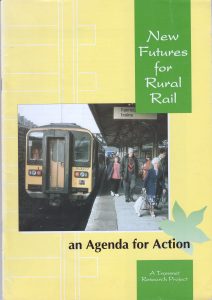 Today, with over 70 community rail partnerships and hundreds of station groups, ‘community rail’ is no longer a purely ‘rural’ initiative, it includes inner urban areas as much as rural branch lines. And it isn’t just about the hardware of the railway; it’s active across a wide range of activities which back then we’d have thought way beyond the scope of what railways should be about. Mental health, loneliness, hate crime, addressing climate change, and lots more, often using art to get people involved and create stations as places that are a delight to use, not places to endure while you wait for your train. Mad optimism? No, it’s already there at some local stations – Smethwick Rolfe Street, Moorthorpe, Kent’s Bank, Burntisland, Beccles, Hindley, Yatton, Heaton Chapel, Betws-y-Coed, Llandovery and dozens more.
Today, with over 70 community rail partnerships and hundreds of station groups, ‘community rail’ is no longer a purely ‘rural’ initiative, it includes inner urban areas as much as rural branch lines. And it isn’t just about the hardware of the railway; it’s active across a wide range of activities which back then we’d have thought way beyond the scope of what railways should be about. Mental health, loneliness, hate crime, addressing climate change, and lots more, often using art to get people involved and create stations as places that are a delight to use, not places to endure while you wait for your train. Mad optimism? No, it’s already there at some local stations – Smethwick Rolfe Street, Moorthorpe, Kent’s Bank, Burntisland, Beccles, Hindley, Yatton, Heaton Chapel, Betws-y-Coed, Llandovery and dozens more.
What they add up to is making rail more people-friendly and encouraging people to use the train and value their local station as a community hub. That feeds back into the really big one of the Climate Emergency. Who was it who once said ‘Think Global – Act Local’?
I see this paper as very much ‘work in progress’ and welcome feedback. It represents a small contribution to the process of growing Community Rail – a healthy and vibrant movement which began with no resources and a lot of scepticism, in the kitchen of a terraced house in Huddersfield thirty years ago. Thanks to all who have contributed to its creation.
A Christmas Railway Ghost Story
What is Christmas without a ghost story? Many years ago I wrote a piece for ASLEF’s Locomotive Journal (December 1985) called ‘Who Signed the Book?’ I’ve carried on tinkering with it and recently posted a slightly revised version on facebook. It’s also on my website and is here: http://lancashireloominary.co.uk/index.html/christmas-ghost-story
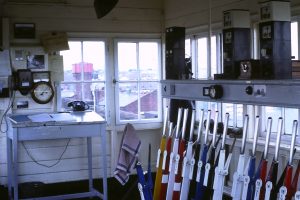
The story is set in my old box – Astley Bridge Junction – before the First World War. As far as I’m aware there never was a disastrous accident on the viaduct, other than me narrowly missing being thrown off it by irate workers from Ryder’s engineering works ‘down below’ who got fed up with being pelted by egg-shells. A tale for another time.
Community Rail Awards
An inspiring range of community rail initiatives, delivered by community groups, partnerships and volunteers across Britain – supporting social inclusion, sustainable travel, empowered communities and economic recovery – have been celebrated at the 17th Community Rail Awards. The awards, hosted by Great Western Railway and South Western Railway, were held at Southampton’s O2

Guildhall. The event was also streamed live online, with more than 300 guests in total, including community rail volunteers, officers, rail industry leaders and government representatives. The event was addressed by transport ministers from the UK, Welsh and Scottish Governments plus industry leaders and personalities passionate about community rail, including Chris Tarrant. The Outstanding Contribution to Community Rail Award was jointly awarded to:
Southeast Communities Rail Partnership, which coordinates activity on eight rail lines across Sussex, Kent, Surrey, and Berkshire, including education and sustainable travel programmes reaching thousands of children, helping adults with additional needs to build rail confidence, and promoting green leisure travel;
Friends of Buxton Station, a volunteer group that has cemented its place at the heart of its community during the pandemic via hugely varied initiatives from arts projects at the station and run digitally, to raising awareness about biodiversity, to improving integrated transport, to supporting local businesses.
A Special Recognition Award, chosen by the Community Rail Network board, was given to Kulvinder Bassi MBE, who was an instrumental member of the community rail team at the Department for Transport from 2006 to 2020 and is now the department’s stations and accessibility policy manager.
South East Lancashire Community Rail Partnership (SELCRP), based in Bolton, fought off strong competition to win the ‘Involving Diverse Groups’ prize at the 17th national Community Rail Awards, also achieving third place in the Influencing Positive Change and Sustainability category.
Raising awareness of Hate Crime
South-east Lancashire CRP won a prestigious award – 1st prize in the ‘Involving Diverse Groups’ category. The partnership’s ‘Hate Crime Awareness Project’ helped to raise public awareness of hate crime, the impact it can have, how it can be reported, and how those affected can access support. Funded by Bolton CVS, the project involved local community groups including Bolton City of Sanctuary, who work with asylum seekers and refugees, and Stand up Sisters who support women with lived experience of mental health issues, substance abuse and sexual/domestic violence in Bolton.
The partnership developed a survey and a series of online workshops in which participants reflected on ways to tackle hate crime, and ran a social media campaign that engaged around 60,000 people. This led to an exhibition of the survey findings, accompanied by art and poetry, that was subsequently put on display at Bolton Station as well as on-line.
The report is available to view at: – https://www.southeastlancscrp.org.uk/wp-content/uploads/2021/12/SELCRP-Hate-Crime-Project-Report-2021.pdf
The CRP also won a third prize for its pioneering ‘Rivington Bus’ project supported by CrossCountry Trains, Horwich Town Council and Diamond Buses NW.
Christmas up North
The following piece was published in Big Issue North – if you get chance, do support the magazine by getting your own copy. There’s always lots of good stuff in it. This is the start of the article:
How did our predecessors in the North celebrate Christmas? There isn’t much written about how ordinary people in different parts of the country marked the festive season a century and more ago. However, many working class men – and some women – wrote dialect stories
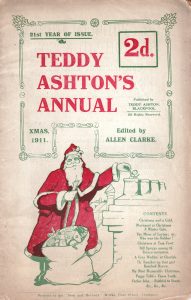
and songs with Christmas settings, mostly in ephemeral paperback ‘almanacs’. Allen Clarke, better known as ‘Teddy Ashton’ produced his Christmas Annual over several decades between 1892 and 1935. John Hartley started publishing his Clock Almanack in Halifax as early as 1865 and it was still going well into the late 1950s, always appearing in December – in time for New Year. Bradford had its own Bob Stubbs’ Original Comic Yorksher Awmynack, published by Watmough’s of Idle, while the Colne Valley had Sam Thropp’s Dialect Annual, published in Slaithwaite and still going strong in the 1960s. Alongside the dialect stories and poems there were numerous adverts for surgical appliances, miracle cures for rheumatism, coughs, colds and bronchitis as well as pills for ‘women’s ailments’!
The ‘almanacs’ shared a common sense of regional pride – in Lancashire and Yorkshire identity. The dialects of the two historic counties have many similarities. Christmas, in south-east Lancashire, was called ‘Kesmas’ whilst in Huddersfield it was ‘Kersmis’. Neither version seems to have survived into the 21st century!
Christmas for a Lancashire or West Riding mill workers’ family wasn’t the sort of extended affair lasting until after New Year. The mills closed on Christmas Day and they’d be back at full power on Boxing Day. Many of the children enjoying the delights of Santa and Christmas dinner would be up as usual at 5 a.m. on Boxing Day ready for a 6 a.m. start. As late as 1900 children as young as 12 worked half-time in the factories; the system was finally abolished in 1918.
Shady dealings along the Golden Mile
Reality is often stranger fiction in the world of politics. Andrew Rosthorn’s book The Oyston Files charts a remarkable story of corruption and intrigue which leaves a very nasty after taste. Rosthorn has spent a lifetime in journalism, including reporting on ‘The Troubles’ in Northern Ireland. While nobody was actually assassinated in Rosthorn’s account of Lancashire political intrigue, it’s fair to say that some lives were ruined.
It’s a complicated story, beginning with the deaths of two young women, one night in August 1975. The two mothers were walking home after a night out in Blackpool and were killed by a car driven by the daughter of a rich businessman, Bill Harrison, who was a staunch supporter of the Conservative Party. Rosthorn charts the attempts of Harrison to get his daughter off the hook. The Lancashire Evening Post (as it then was) saw the potential of a major political scandal and they pulled no punches in their reporting of the case.
The entirely honourable role of the Evening Post stands out in Rosthorn’s account. The ‘Harrison Case’ exposed corrupt practices within Lancashire County Council and the Lancashire Constabulary. Harrison was determined to ‘get’ the paper and a particular focus of his anger directed towards Owen Oyston, a Blackpool-based estate agent who was a major advertiser in the paper and a Labour Party supporter into the bargain. He had a majority share in Blackpool Football Club – a powerful and influential figure. Harrison assumed, probably wrongly, that Oyston was behind what he regarded as a ‘witch-hunt’ directed at himself.
Oyston was ‘no angel’ and Harrison was quickly able to identify his weakness – sexual relations with young women, barely over the age of consent. Harrison hired a former fish and chip shop owner called Michael Murrin who pursued Oyston over a period of ten years. In 1996 Oyston was accused of rape and indecent assault of two 16-year old girls, from a model agency. At the time of the alleged rapes Oyston was 58. Following three consecutive trials he was found guilty of the rape of one of the young women – ‘Miss H’. He was sentenced to six years imprisonment and served three years and six months.
Such are the bare bones of a story of very dirty dealings which had national political repercussions. Rosthorn presents strong arguments that Oyston was ‘set up’ by powerful forces within the Lancashire establishment who were determined to ‘bring him down a peg or two’. He makes extensive use of court transcripts and telephone conversations. He raises some serious questions about the way the trials were conducted, with some evidence not being taken into consideration.
I would say a weakness of Andrew’s book is his too-casual dismissal of the two female defendants as, in effect, the real criminals. There is no question that he had inappropriate relations with both of the young women and – as the judge observed when Oyston was being sentenced – abused his position of power into effectively coercing the girls into having sex with him. Whether you would call that ‘rape’ is open to interpretation. The prosecuting lawyer, Helen Grindrod QC, was a feminist when it wasn’t exactly a professional asset in the very male world of the law, championing the cause of vulnerable women in rape cases. This is to her credit, but sadly she doesn’t get any of that in the book, which ends with an unnecessary account of her ‘celebrating’ Oyston’s conviction.
What emerges from The Oyston Files is how much has changed since the ‘man’s world’ that was the last quarter of the 20th century. But could the same thing happen again? Well, some high profile cases involving members of the Royal Family suggest it might. There were very specific circumstances surrounding the Oyston Affair which reflect badly on our local polity and the nefarious influence of the moneyed class on our justice system.
Read it and make up your own mind – it’s gripping stuff that would make a remarkable film. The Oyston Files by Andrew Rosthorn is available on Amazon ISBN 9781916096349
Colin Speakman’s Yorkshire
Colin Speakman is a Lancastrian by birth, long exiled in Yorkshire where he has, without doubt, ‘gone native’. Yorkshire, and perhaps Colin himself, is all the better for it. He has made a huge contribution to public transport over many decades, bringing a very strong emphasis 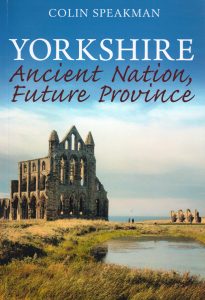 on the importance of leisure transport. I think it’s fair to say that he has developed an unrivalled knowledge of his adopted shire, bringing all the zeal of a convert to his work, not least for The Yorkshire Society.
on the importance of leisure transport. I think it’s fair to say that he has developed an unrivalled knowledge of his adopted shire, bringing all the zeal of a convert to his work, not least for The Yorkshire Society.
His latest book – which I hope isn’t his swansong as there’s plenty life in the old bxxxxr yet – is Yorkshire –ancient nation, future province. It’s very much about the importance of identity, but this is no backward-looking journey of nostalgia. Colin has an excellent knowledge of Yorkshire history and this comes out in the book very well, but he also has an exciting vision of a modern Yorkshire, in all its creative diversity.
The book was published in August and the malign presence of Covid is apparent from the start, with Colin reflecting that “the world as it was in 2019 will never return.” And always the optimist, he goes on to suggest that while local authorities will be squeezed for cash and some services will be lost, “it could also be a greener future, one in which people get out of their cars and walk, cycle and use trains more, and appreciate the environment and natural world that exists all around them.” I hope he’s right.
This is a strongly political book but one which I would hope people from different backgrounds could appreciate and learn something from. Colin is a committed regionalist and an important part of the book is Colin’s development of the idea of ‘cultural landscapes’, identifying nine such parts of the historic country, each of which has its own distinctive identity within Yorkshire. This approach could well be applied to the county’s western neighbour, Lancashire, which has been mucked about with even more than Yorkshire itself. Re-creating a distinct over-arching Lancashire with its distinctive ‘cultural landscapes’ (Manchester, the South-east Lancashire ‘cotton belt’, West and East Lancashire, Merseyside and ‘Lancashire North of the Sands’ as an initial shot) is an attractive idea and one which I hope to work on in my forthcoming Greater Lancashire, which I hope to complete next year. Well, I suppose I need to start it first. I think Colin’s term ‘cultural landscapes’ is helpful but maybe not quite right. Perhaps ‘micro-regions’ within a Yorkshire ‘region’ instead of ‘province’? Is ‘region’ a stronger term than ‘province’? Possibly. I remember back in the 1990s the idea of a ‘micro-region’ was popular amongst environmentalists in parts of eastern Europe.
It’s great that Colin has started this debate and I look forward to him developing the idea further. In the meantime, do get his book, as you would expect from this veteran (but not quite vintage) writer, it’s a pleasure to read.
Published by Gritstone at £`12.50 (how does he manage to get it that cheap?)
Christmas Quiz: 21 of the worst
I’m grateful to Steve Leyland for some of the questions in this year’s quiz. See how you get on, correct answers (and winners) will be published in the next issue. It’s very nerdish and very male (pretty much 90% of my readers I suppose). Some of the questions were
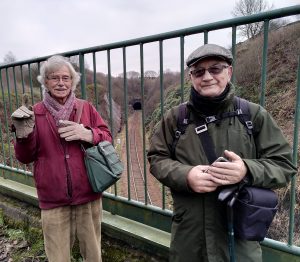
trialled over a pint in the Crown and Thistle, a lonely moorland pub set above Sough Tunnel on the Roman Road. What that has got to do with it, I don’t know. I can’t stop you using google but let’s face it, it spoils the fun…
- Which Snowdon Mountain Railway station is mentioned in The Bible?
- What was the last class of loco on BR to have any withdrawals?
- Which Lancashire station was originally called ‘Poulton-le-Sands’?
- Which Victorian author was involved in a serious railway accident – and where was it?
- In American railroad slang what is a) a ‘drag’ b) ‘Highball’ (verb) and c) a ‘hog mauler’
- How many nicknames were applied to the ‘Austerity’ 2-8-0s (name them)
- Which of the following musical figures were railway enthusiasts: Jools Holland; Antonin Dvorak; E.J. Moeran; Rod Stewart; Neil Young; Beethoven
- If you were a footplateman returning to depot by train after completing your job, how would you be travelling?
- If your train was detained at a red signal close to a signalbox, what would you have to do – and who would do it?
- What was it that ripped Frank Zappa’s flesh?
- Which Lancashire rural location once hosted a concert at which Captain Beefheart performed? Extra point for name of the Community Rail Officer who attended
- Which folk singer recorded ‘Moses of the Mail’ and which loco shed was Moses from?
- Which composer wrote a symphony set on the Diggle Route?
- What was the name of the piece of music composed specially to be performed at a Northern Rail depot open day? Name composer and depot for extra points
- Who was the great Welsh poet who was also a stationmaster at a remote junction?
- What task did Dvorak allocate to his future son-in-law and why was he disappointed with the result?
- In the gospel song, what line is Jesus on?
- Which Glasgow and South Western Railway inspector was an accomplished poet and writer of religious hymns? And which depot features in one of his poems?
- What action did C.B. Collett take when a group of GWR apprentices went on strike?
- In ‘The Night Mail’ how well was the train performing on Beattock Bank?
- In the Summer 1958 Ian Allan Combined Volume, what is the only named class to be in alphabetical order?
Lancashire Loominary publications and special offers to readers
My new biography of Lancashire writer, railway lover, cyclist and philosopher Allen Clarke (aka ‘Teddy Ashton’ is now available. Salvo 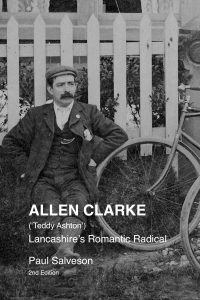 subscribers can get Lancashire’s Romantic Radical for £15 instead of normal price of £18.99. I’ve some copies of my Moorlands, Memories and Reflections for £15 (reduced from £21) as well as my novel set in Horwich Loco Works (The Works) for £6. More esoteric but interesting is With Walt Whitman in Bolton: spirituality, sex and socialism in a Northern Mill Town. Also £6, not that much sex in it to be honest – but it has compensations. See www.lancashireloominary.co.uk
subscribers can get Lancashire’s Romantic Radical for £15 instead of normal price of £18.99. I’ve some copies of my Moorlands, Memories and Reflections for £15 (reduced from £21) as well as my novel set in Horwich Loco Works (The Works) for £6. More esoteric but interesting is With Walt Whitman in Bolton: spirituality, sex and socialism in a Northern Mill Town. Also £6, not that much sex in it to be honest – but it has compensations. See www.lancashireloominary.co.uk
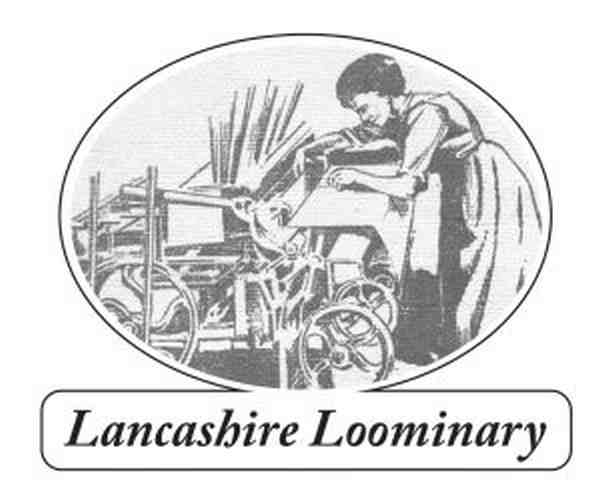
4 replies on “Weekly Salvo 300”
Thank you Paul for remembering the tragic loss to REPTA & its Membership of Bryan Price & Ian Roden during the past troubled period.
I trust our 2022 Yearbook & Membership card have arrived safely produced successfully in a very trying time for REPTA
Paul:
Congrats on passing milestone 300 with a full head of steam
As usual Paul full of useful info & a devilishly tricky quiz . Think I scored 3 percent correct answers
I enjoyed reading this. Especially useful was the explanation of the proposed northern railway(s) from Liverpool to Manchester.